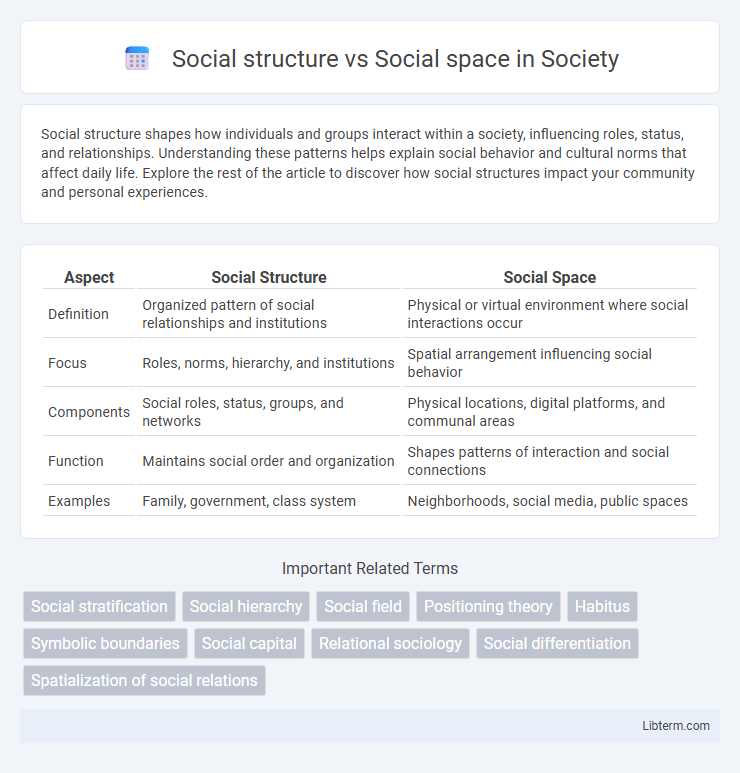Social structure shapes how individuals and groups interact within a society, influencing roles, status, and relationships. Understanding these patterns helps explain social behavior and cultural norms that affect daily life. Explore the rest of the article to discover how social structures impact your community and personal experiences.
Table of Comparison
| Aspect | Social Structure | Social Space |
|---|---|---|
| Definition | Organized pattern of social relationships and institutions | Physical or virtual environment where social interactions occur |
| Focus | Roles, norms, hierarchy, and institutions | Spatial arrangement influencing social behavior |
| Components | Social roles, status, groups, and networks | Physical locations, digital platforms, and communal areas |
| Function | Maintains social order and organization | Shapes patterns of interaction and social connections |
| Examples | Family, government, class system | Neighborhoods, social media, public spaces |
Introduction to Social Structure and Social Space
Social structure refers to the organized pattern of social relationships and social institutions that together form the basis of society, including roles, norms, and hierarchies. Social space, on the other hand, denotes the physical and symbolic environments where social interactions occur, shaped by factors such as geography, urban planning, and cultural contexts. Understanding the distinction between social structure and social space is essential for analyzing how societal organization influences human behavior within different environments.
Defining Social Structure
Social structure refers to the organized patterns of relationships and social institutions that shape society, including roles, norms, and hierarchies. It defines how individuals and groups interact within networks of social organization such as family, class, and government. Understanding social structure is essential for analyzing societal stability, power dynamics, and social behavior.
Understanding Social Space
Social space refers to the tangible and intangible environments where social interactions and relationships occur, shaped by factors such as geography, social networks, and cultural norms. Understanding social space involves analyzing how individuals and groups navigate these environments, how power dynamics manifest in spatial arrangements, and how social identities influence access and movement within these spaces. This concept extends beyond physical locations to include digital and symbolic spaces, highlighting the complex interplay between spatial structures and social behavior.
Key Differences Between Social Structure and Social Space
Social structure refers to the organized patterns of relationships and social institutions that shape society, including roles, norms, and hierarchies. Social space, on the other hand, denotes the physical and symbolic environments where social interactions and relationships occur, influenced by cultural and spatial contexts. Key differences include social structure's emphasis on systemic organization and stability, whereas social space focuses on the dynamic and situated interactions within specific locations or contexts.
Historical Perspectives on Social Organization
Historical perspectives on social organization reveal that social structure refers to the enduring patterns of relationships and hierarchies within a society, while social space encompasses the physical and symbolic arenas where social interactions occur. Early sociologists like Emile Durkheim emphasized the role of social structure in maintaining social order, whereas Henri Lefebvre introduced the concept of social space to analyze how power dynamics are embedded in spatial arrangements. The interplay between social structure and social space highlights how historical contexts shape both societal frameworks and the lived experiences within those environments.
Theoretical Approaches: Structure vs. Space
Theoretical approaches to social structure emphasize hierarchical relationships, roles, and institutions that organize society into stable patterns of interaction, whereas social space theories focus on the spatial distribution of these interactions and how physical or symbolic locations influence social behavior and power dynamics. Structuralists analyze social roles, norms, and networks as fixed frameworks shaping individual actions, while social space theorists examine how geographical, cultural, and symbolic spaces create fluid and dynamic contexts for social practices. These contrasting perspectives reveal how social power is both embedded in institutional structures and exercised through spatial relations and territorial arrangements.
Social Structure in Modern Societies
Social structure in modern societies refers to the organized patterns of relationships and institutions that shape social behavior and interactions, including class systems, political institutions, and family units. It defines hierarchical arrangements based on roles, statuses, and norms that regulate individual and group behavior within a complex division of labor. Understanding social structure highlights the influence of systemic factors such as socioeconomic status, institutional power, and cultural expectations on shaping social outcomes and individual opportunities.
Mapping and Measuring Social Space
Mapping and measuring social space involves analyzing the dynamic relationships and interactions between individuals and groups within a society, highlighting spatial patterns of social behavior and influence. Unlike static social structure, which emphasizes hierarchical positions and roles, social space captures fluid connections shaped by power, resources, and cultural capital distribution. Techniques like network analysis, spatial statistics, and geospatial mapping provide empirical data to visualize and quantify social proximity, inequality, and segregation across urban and organizational contexts.
Interrelation of Structure and Space in Social Dynamics
Social structure defines the organized patterns of social relationships and institutions, while social space refers to the physical and symbolic environments where these interactions occur. The interrelation of structure and space shapes social dynamics by influencing how power, identity, and social networks are produced and reproduced within specific spatial contexts. Spatial arrangements both reflect and reinforce social hierarchies, enabling a dynamic interplay where structure shapes access and behavior, and space mediates social interactions and collective experiences.
Implications for Social Research and Policy
Social structure refers to the organized patterns of relationships and social institutions that shape societal interactions, while social space encompasses the physical and symbolic environments where these interactions occur. Understanding the distinction is crucial for social research and policy, as analyzing social structure reveals systemic inequalities and institutional dynamics, whereas examining social space highlights spatial segregation and access disparities. Policies informed by this dual perspective can more effectively address both structural causes of social issues and their spatial manifestations, leading to targeted interventions and equitable resource distribution.
Social structure Infographic

 libterm.com
libterm.com